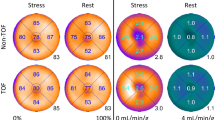Abstract
Background
Time-of-flight (TOF) is known to increase signal-to-noise ratio (SNR) and facilitate reductions in administered activity. Established measures of SNR gain are derived from areas of uniform uptake, which is not applicable to the heterogeneous uptake in cardiac PET images using fluoro-deoxyglucose (FDG). This study aimed to develop a technique to quantify SNR gains within the myocardium due to TOF.
Methods
Reference TOF SNR gains were measured in 88 FDG oncology patients. Phantom data were used to translate reference SNR gains and validate a method of quantifying SNR gains within the myocardium from parametric images produced from multiple replicate images. This technique was applied to 13 FDG cardiac viability patients.
Results
Reference TOF SNR gains of +23% ± 8.5% were measured in oncology patients. Measurements of SNR gain from the phantom data were in agreement and showed the parametric image technique to be sufficiently robust. SNR gains within the myocardium in the viability patients were +21% ± 2.8%.
Conclusion
A method to quantify SNR gains from TOF within the myocardium has been developed and evaluated. SNR gains within the myocardium are comparable to those observed by established methods. This allows guidance for protocol optimization for TOF systems in cardiac PET.




Similar content being viewed by others
Abbreviations
- BMI:
-
Body mass index
- FDG:
-
Fluoro-deoxyglucose
- PET:
-
Positron Emission Tomography
- SNR:
-
Signal-to-noise ratio
- TOF:
-
Time-of-flight
References
Conti M, Bendriem B, Casey M, Chen M, Kehren F, Michel C, et al. First experimental results of time-of-flight reconstruction on an LSO PET scanner. Phys Med Biol 2005;50:4507-26.
Surti S, Kuhn A, Werner ME, Perkins AE, Kolthammer J, Karp JS. Performance of Philips gemini TF PET/CT scanner with special consideration for its time-of-flight imaging capabilities. J Nucl Med 2007;48:471-80.
Budinger TF. Time-of-flight positron emission tomography: Status relative to conventional PET. J Nucl Med 1983;24:73-8.
Kadrmas DJ, Casey ME, Conti M, Jakoby BW, Lois C, Townsend DW. Impact of time-of-flight on PET tumor detection. J Nucl Med 2009;50:1315-23.
Kadrmas DJ, Oktay MB, Casey ME, Hamill JJ. Effect of scan time on oncologic lesion detection in whole-body PET. IEEE Trans Nucl Sci 2012;59:1940-7.
Armstrong IS, James JM, Williams HA, Kelly MD, Matthews JC. The assessment of time-of-flight on image quality and quantification with reduced administered activity and scan times in 18F-FDG PET. Nucl Med Commun 2015;36:728-37.
DiFilippo FP, Brunken RC. Impact of time-of-flight reconstruction on cardiac PET images of obese patients. Clin Nucl Med 2017;42:e103-8.
Oldan JD, Shah SN, Brunken RC, DiFilippo FP, Obuchowski NA, Bolen MA. Do myocardial PET–MR and PET–CT FDG images provide comparable information? J Nucl Cardiol 2016;23:1102-9.
Conti M, Eriksson L, Westerwoudt V. Estimating image quality for future generations of TOF PET scanners. 2011 nuclear science symposium conference record (NSS/MIC); 2011:2407-2414
Akamatsu G, Ishikawa K, Mitsumoto K, Taniguchi T, Ohya N, Baba S, et al. Improvement in PET/CT image quality with a combination of point-spread function and time-of-flight in relation to reconstruction parameters. J Nucl Med 2012;53:1716-22.
Lois C, Jakoby BW, Long MJ, Hubner KF, Barker DW, Casey ME, et al. An assessment of the impact of incorporating time-of-flight information into clinical PET/CT imaging. J Nucl Med 2010;51:237-45.
McDermott G, Chowdhury F, Scarsbrook A. Evaluation of noise equivalent count parameters as indicators of adult whole-body FDG-PET image quality. Ann Nucl Med 2013;27:855-61.
Yu M, Nekolla SG, Schwaiger M, Robinson SP. The next generation of cardiac positron emission tomography imaging agents: Discovery of flurpiridaz F-18 for detection of coronary disease. Semin Nucl Med 2011;41:305-13.
Berman DS, Maddahi J, Tamarappoo BK, Czernin J, Taillefer R, Udelson JE, et al. Phase II safety and clinical comparison with single-photon emission computed tomography myocardial perfusion imaging for detection of coronary artery disease. J Am Coll Cardiol 2013;61:469-77.
Cerqueira MD, Allman KC, Ficaro EP, Hansen CL, Nichols KJ, Thompson RC, et al. Recommendations for reducing radiation exposure in myocardial perfusion imaging. J Nucl Cardiol 2010;17:709-18.
Dorbala S, Blankstein R, Skali H, Park MA, Fantony J, Mauceri C, et al. Approaches to reducing radiation dose from radionuclide myocardial perfusion imaging. J Nucl Med 2015;56:592-9.
Jakoby BW, Bercier Y, Conti M, Bendriem B, Townsend D. Physical and clinical performance of the mCT time-of-flight PET/CT scanner. Phys Med Biol 2011;56:2375-89.
Schmidtlein CR, Beattie NJ, Bailey DL, Akhurst TJ, Wang W, Gonen M, et al. Using an external gating signal to estimate noise in PET with an emphasis on tracer avid tumors. Phys Med Biol 2010;55:6299-326.
Levin CS, Maramraju SH, Khalighi MM, Deller TW, Delso G, Jansen F. Design features and mutual compatibility studies of the time-of-flight PET capable GE SIGNA PET/MR system. IEEE Trans Med Imaging 2016;35:1907-14.
Queiroz MA, Delso G, Wollenweber S, Deller T, Zeimpekis K, Huellner M, et al. Dose optimization in TOF-PET/MR compared to TOF-PET/CT. PLoS ONE 2015;10:e0128842.
Acknowledgements
The authors wish to extend their thanks to colleagues Kimberley Saint and Matthew Memmott for conscientious proof reading of this manuscript prior to submission.
Disclosure
There are no conflicts of interest for Ian Armstrong, Christine Tonge, and Parthiban Arumugam associated with this study.
Author information
Authors and Affiliations
Corresponding author
Additional information
The authors of this article have provided a PowerPoint file, available for download at SpringerLink, which summarizes the contents of the paper and is free for re-use at meetings and presentations. Search for the article DOI on SpringerLink.com.
Electronic supplementary material
Below is the link to the electronic supplementary material.
Rights and permissions
About this article
Cite this article
Armstrong, I.S., Tonge, C.M. & Arumugam, P. Assessing time-of-flight signal-to-noise ratio gains within the myocardium and subsequent reductions in administered activity in cardiac PET studies. J. Nucl. Cardiol. 26, 405–412 (2019). https://doi.org/10.1007/s12350-017-0916-x
Received:
Accepted:
Published:
Issue Date:
DOI: https://doi.org/10.1007/s12350-017-0916-x




